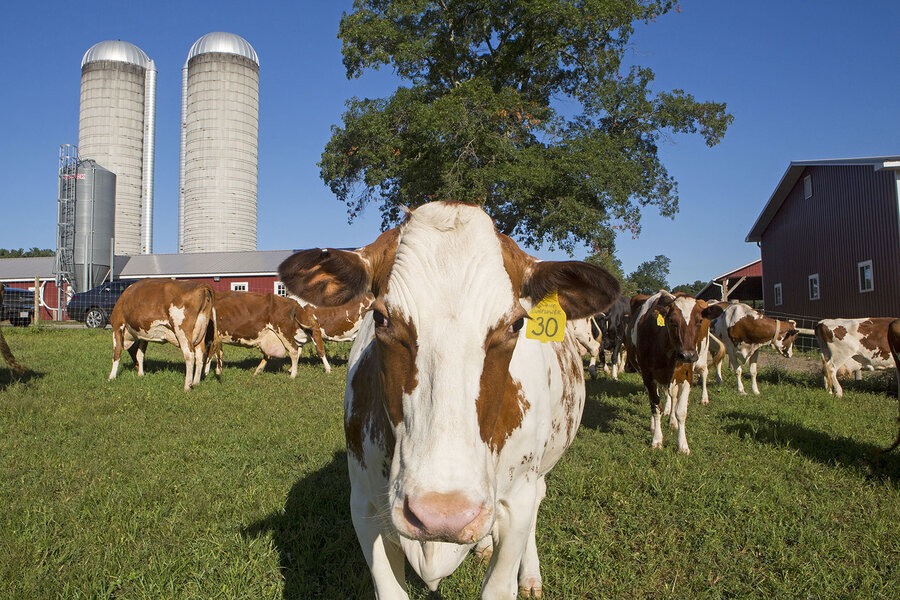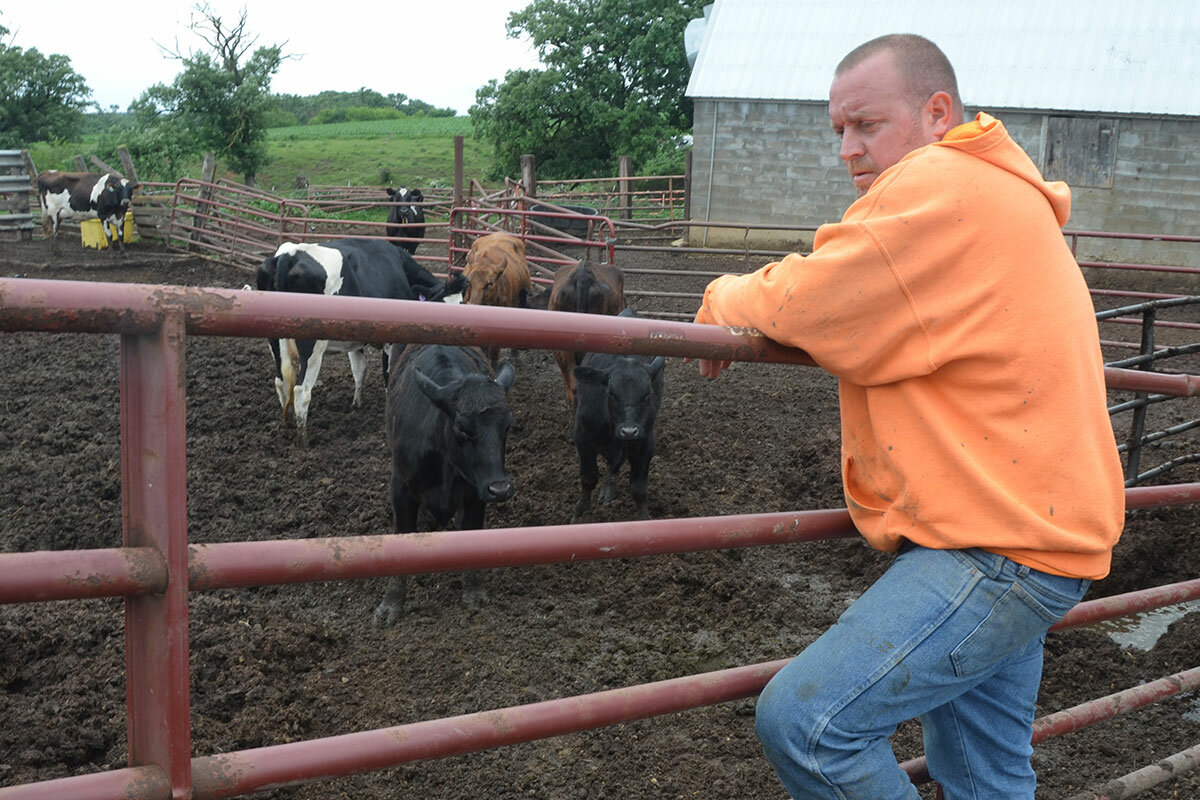Slumping milk prices force dairy farmers to think outside the barn
Loading...
| New Diggings, Wis.
Twelve years ago, Terry Edge, in his mid 20s and descended from Wisconsin dairy farmers, turned his back on the family business and took a job in construction. It didn’t last long. Six months later he bought 50 cows, moved them into his grandfather’s old barn, and threw himself into the subtleties of cow breeding, determined not just to follow the old dairying life but to improve on it, raising animals that were healthier and better suited to grazing on the lush green hillsides of southwest Wisconsin.
“I went that route thinking it would help me make ends meet,” he says. “But it didn’t work out that way.”
Now Mr. Edge has come to the end of the line. He sold most of his cows at an auction last month, undone by a stretch of low milk prices that has lasted 3-1/2 years and imperiled dairy farmers across the country.
Why We Wrote This
Dairy farmers have seen low milk prices before, but the current downturn has been severe in its duration. As some dairy farms fail, others are finding new paths forward.
Some like Edge are being forced out of the dairy business. For others, the hard times are focusing new attention on strategies that go beyond just milking cows in big barns, such as making cheeses or switching to goats or sheep. And some farmers, pointing to a quota system of production in Canada that keeps milk prices more stable there, say new policies might be the answer.
“This is probably the biggest challenge dairy farmers have faced in their lifetime,” says Darin Von Ruden, a dairy farmer and president of the Wisconsin Farmers Union.
Overproduction worldwide has yielded a glut of milk, driving prices below what farmers say it costs them to produce it, for months at a time. Farmers are used to fluctuations in milk prices, but previous downturns have usually lasted only a year or 18 months.
The US Department of Agriculture predicts that milk prices will rise this year and into next. But no one expects a big increase. The Trump administration’s trade disputes and the prospect of trade wars involving agricultural products have only deepened the uncertainty.
‘Running as fast as we can’
As this downturn reaches the middle of the fourth year, many farmers are struggling just to hang on, borrowing against land and equipment to pay their bills, betting the farm that prices will turn.
“Once you’ve invested a million dollars in a milking parlor, you’re going to milk cows,” says Sarah Lloyd, a farmer in Wisconsin Dells. The result, she says, is that “my husband and I are on the treadmill and we’re running as fast as we can. That’s happening to a lot of families.”
Not all farmers are struggling. Some have managed to pay down debts. And, as in other types of farming, large operations often enjoy economies of scale. Big farms can run milking parlors around the clock and negotiate discounts for things like feed and breeding services.
Wisconsin alone lost about 5 percent of its dairy farms between 2016 and 2017. Just 15 miles west of Edge’s farm, William and Kelle Calvert had gone into debt to buy a 450-acre farm, and gave up dairying because they were afraid of losing everything. They sold their cows to save the farm. Now they cash-crop corn, soybeans, and hay and raise a few animals for other people.
“We had a good sale,” says Mr. Calvert, who now works at an agricultural feed company. “There were tears shed, but we felt it was a good day.”
Finding new pathways
The milk crisis has also inspired farmers to think harder about new strategies with their dairy herds, including alternatives to conventional dairying. Some are championing rotational grazing, a method that involves sending cows out to pastures rather than confining them in big barns, as many dairy farms do. Grazing requires a lower investment in buildings, machinery and feed, and dairy experts say it offers a small economic advantage over conventional dairying.
Organic milk production has for decades offered a profitable alternative for smaller farms, and although organic milk prices have fallen recently, too, organic producers haven’t suffered as much as conventional producers.
Other farmers are trying to diversify, raising beef cattle or producing milk for a niche market. Some have switched to milking goats or sheep; the number of goat and sheep farms in Wisconsin almost doubled between 2015 and 2017. Richard Cates, who directs the Wisconsin School for Beginning Dairy and Livestock Farmers, says he “can’t imagine” starting out as a conventional dairy farmer these days. “You have to be innovative and entrepreneurial,” he says. “You have to do what other people are not doing.”
The Marcoot Jersey Creamery, in Greenville, Ill., is one example. It grew out of a common predicament: an older farmer thinking of selling his cows. Instead, he and two daughters started a cheese-making operation on the farm in 2010. Today Marcoot has 14 employees and about 100 cows. It makes 20 varieties of cheese, which it sells at an on-farm store and ships to scores of restaurants and grocery stores in the Midwest.
“It made the most economic sense to turn the milk into cheese,” says Laura Wall, who gives tours on the farm.
Meanwhile, some young people are still finding a way – carefully – into dairy farming. John Richmond, who is 24, is a grazer, feeding his cows grass and hay that he grows himself. He has avoided massive debt by renting rather than buying land and equipment. He’s still not sure if he’ll break even.
Mr. Richmond is a realist: If he can’t make a living as a dairy farmer, he’ll switch to some other kind of farming. “Really,” he says, “someone could do anything with this land.”
A model in Canada?
As farmers struggle, agricultural agencies in dairy states are trying to help, offering financial advice, credit mediation services, and access to counseling. But across the countryside, farmers are feeling angry and bewildered.
“Our pride and perseverance has allowed us to survive the hardships of the past,” wrote Thomas Litkea, a 67 year-old farmer in New Lisbon, Wis., in a recent letter to Dairy Star magazine. “However, we need actions and answers now more than ever.”
A growing number of Midwestern dairy farmers are showing an interest in policies that would raise milk prices by controlling production. They’ve looked to Canada, which has a supply management system that imposes quotas on farmers (and barriers on imports from countries like the United States).
“It has kept prices stable,” says Alan Ker, director of the Institute for the Advanced Study of Food and Agricultural policy at the University of Guelph in Guelph, Ont. “It takes out a lot of risk for farmers.”
This spring, hundreds of farmers converged on meetings in Michigan and Wisconsin to hear about the Canadian system directly from Ontario dairy farmers. “As farmers especially, we need to take a look at why we keep producing more and more when there’s no market for it,” says Mr. Von Ruden, who helped organize the meetings.
On his farm in New Diggings, Terry Edge decided he could no longer make it work. On a recent morning, there’s activity everywhere. Hunting dogs strain at their leashes, turkeys waddle through the long grass, and calves bawl in small sheds. The yard is muddy from an early downpour.
Looking to his next chapter, this fifth-generation dairy farmer is now planning to raise beef. “My hope is within two years to have maybe 100, 120 beef cattle,” Edge says. He’ll have more time for work off the farm. He’ll also have more time at home with his wife (a nurse) and three children, who were often asleep by the time he got home from milking his cows.
But the farming won’t be the same. He’ll miss the close work with his cows, the familiarity with them that for many farmers is both the pleasure and burden of dairy farming.
He walks to the edge of a large pen, not far from the barn, where a small, brindled cow strains against the wooden fence. He reaches down and scratches the coarse hair between its ears.
“Any dairy farmer will tell you, it’s more the interaction with the animals than anything else,” he says. “That’s what I’ll miss the most.”






